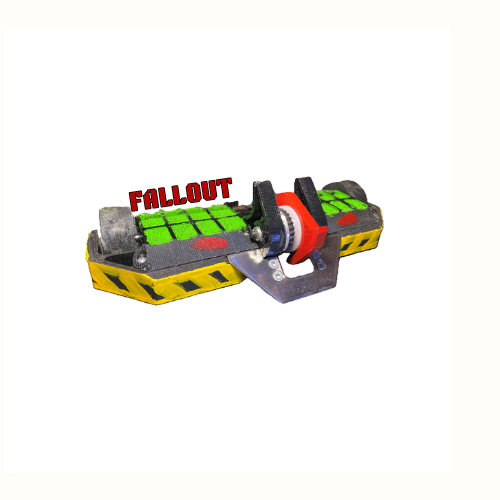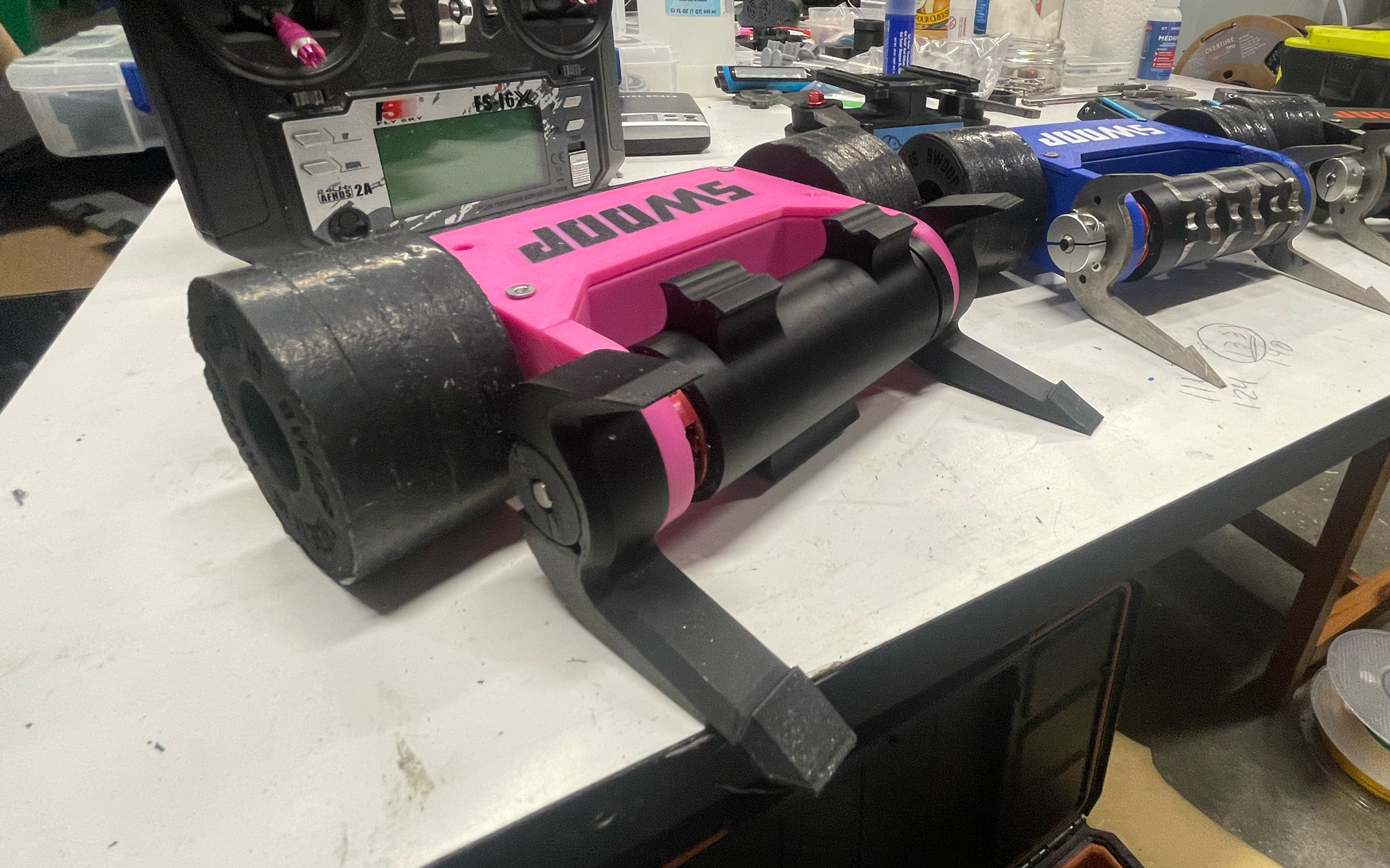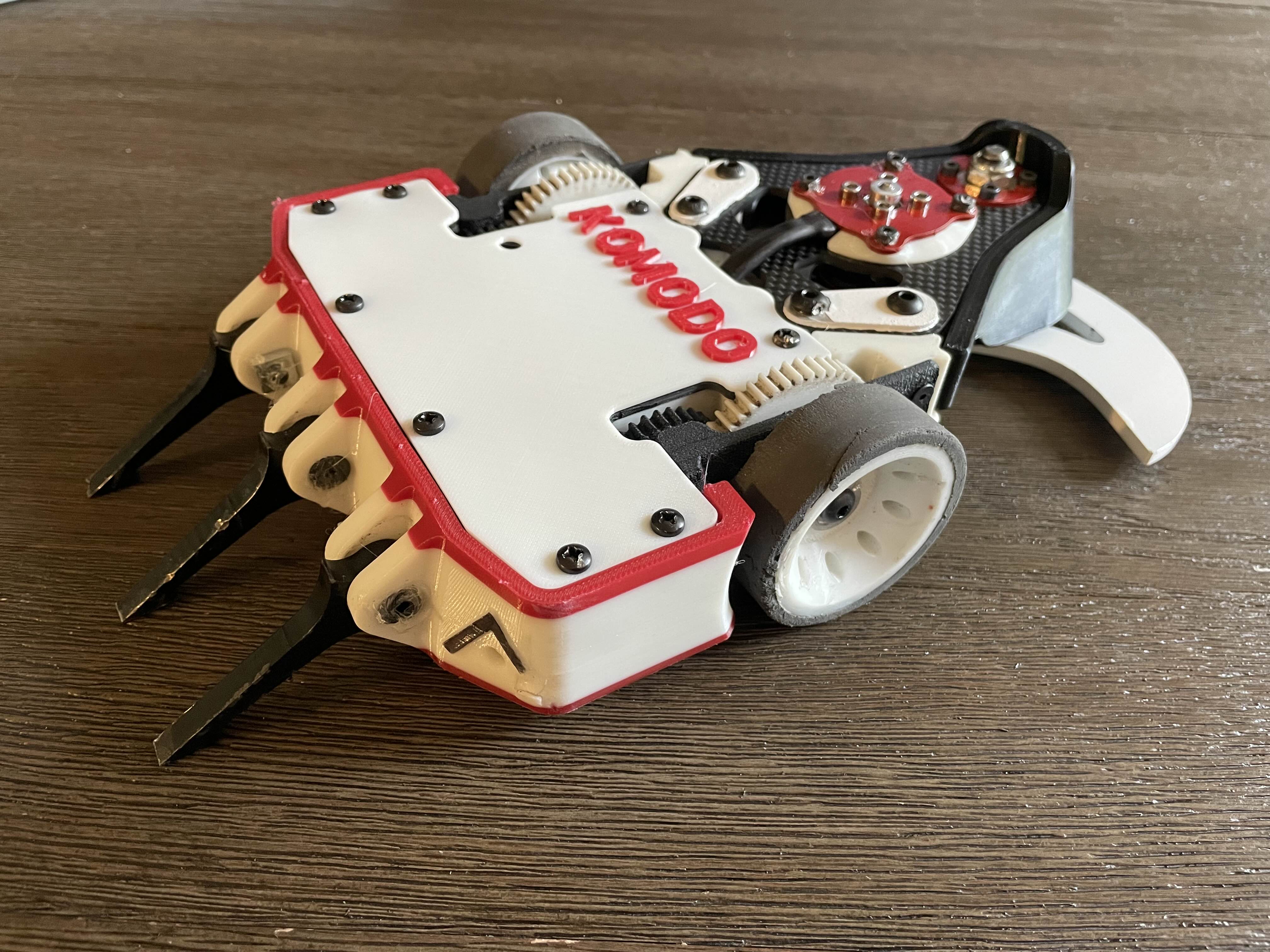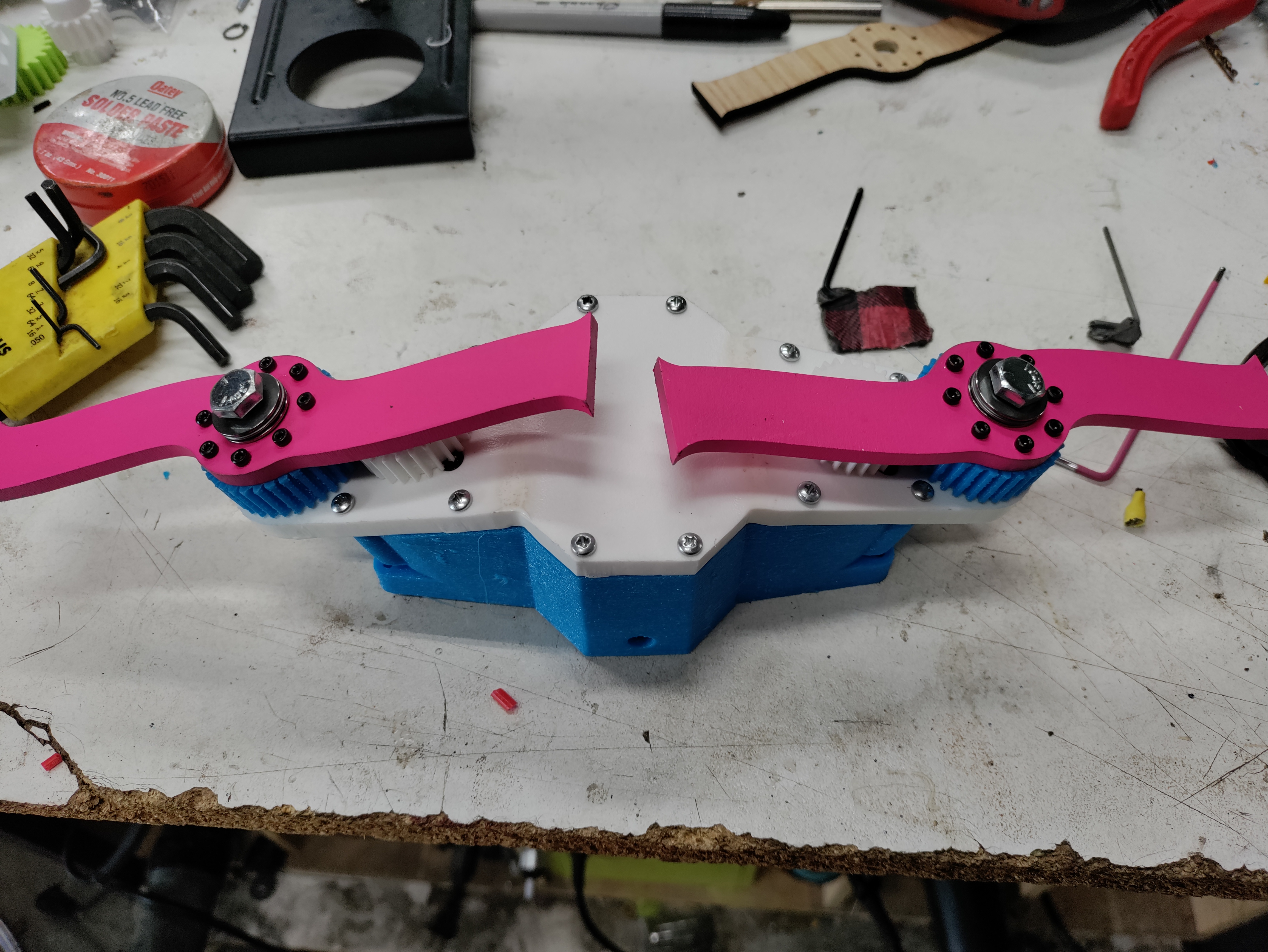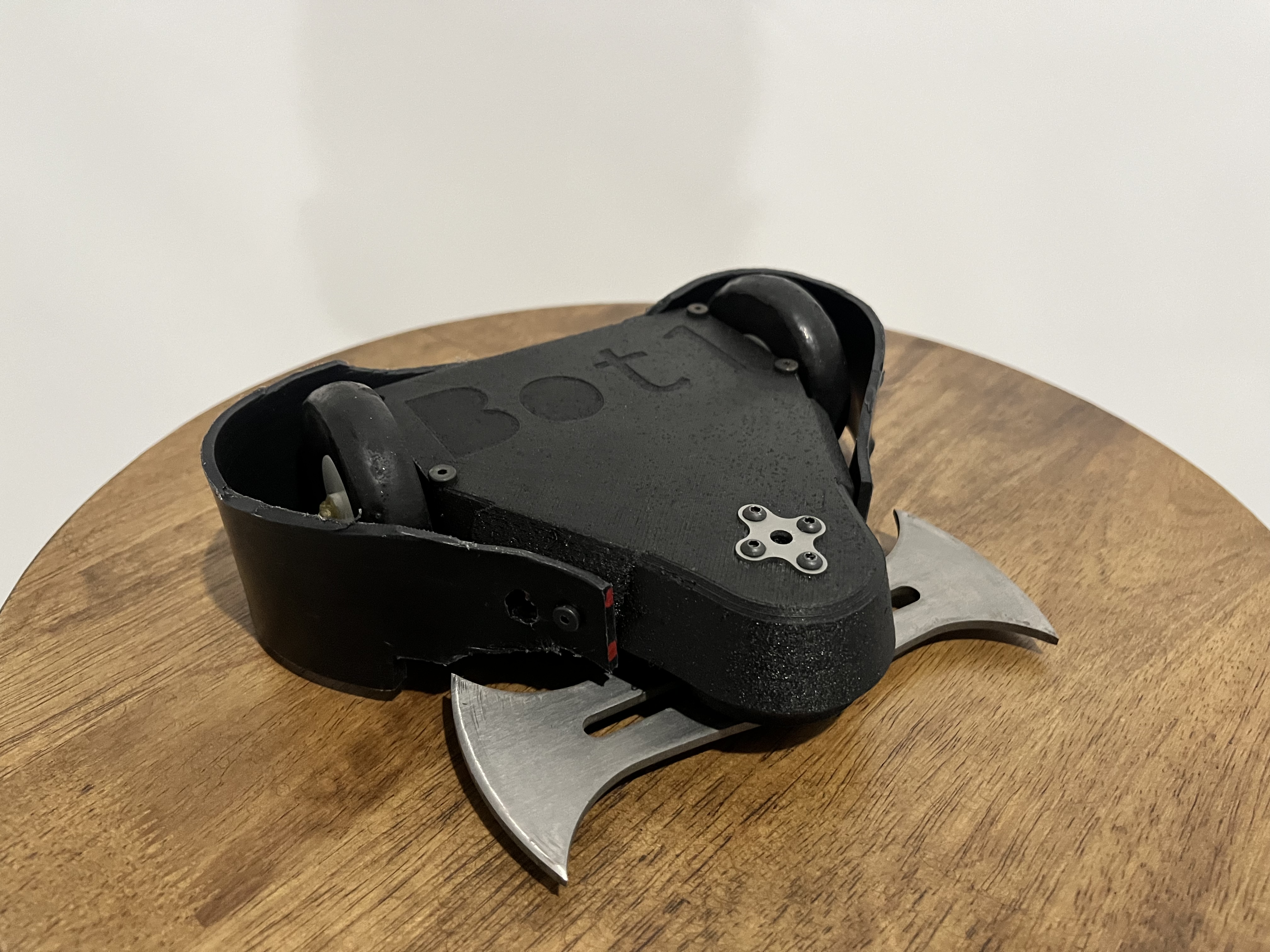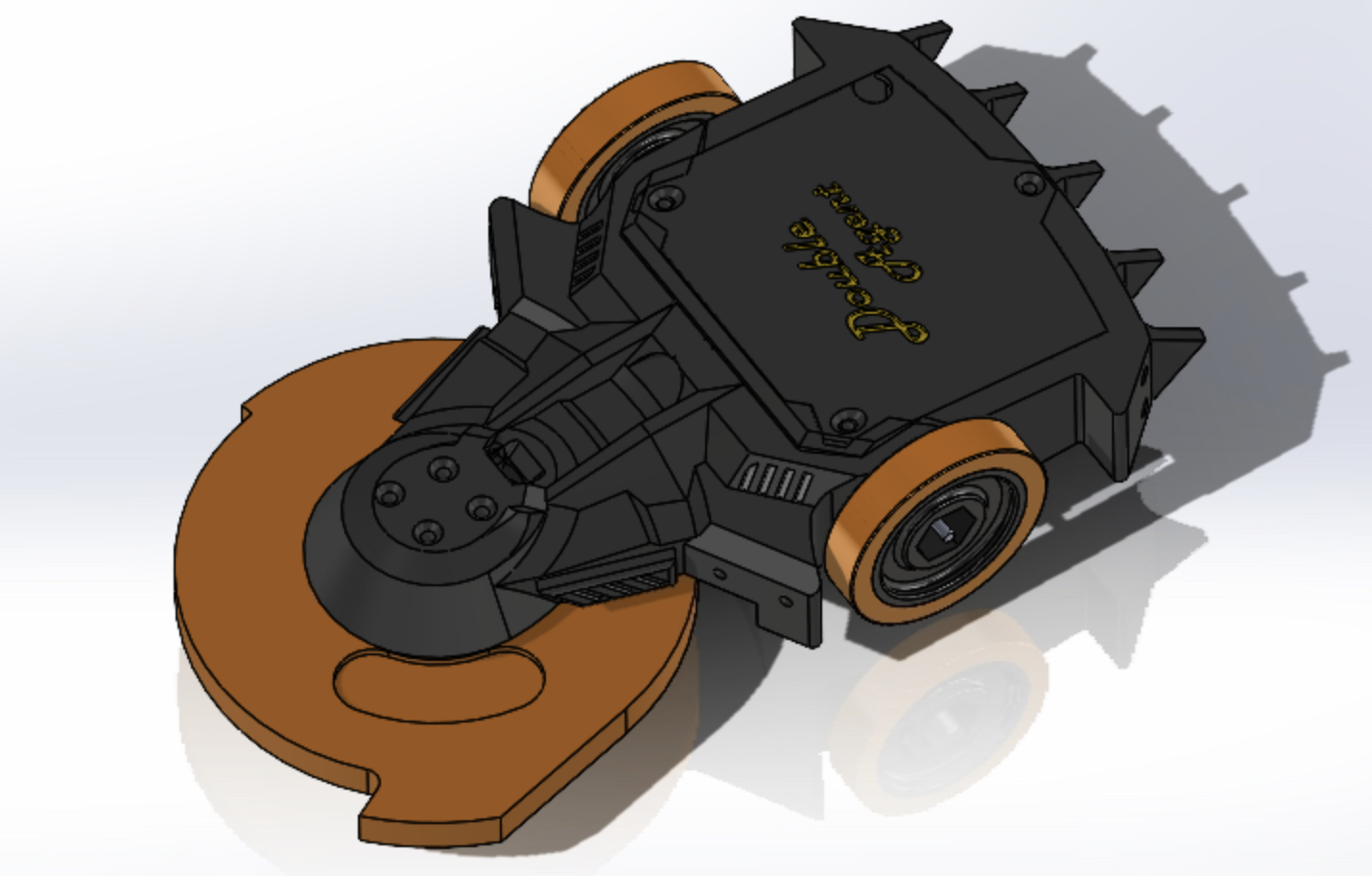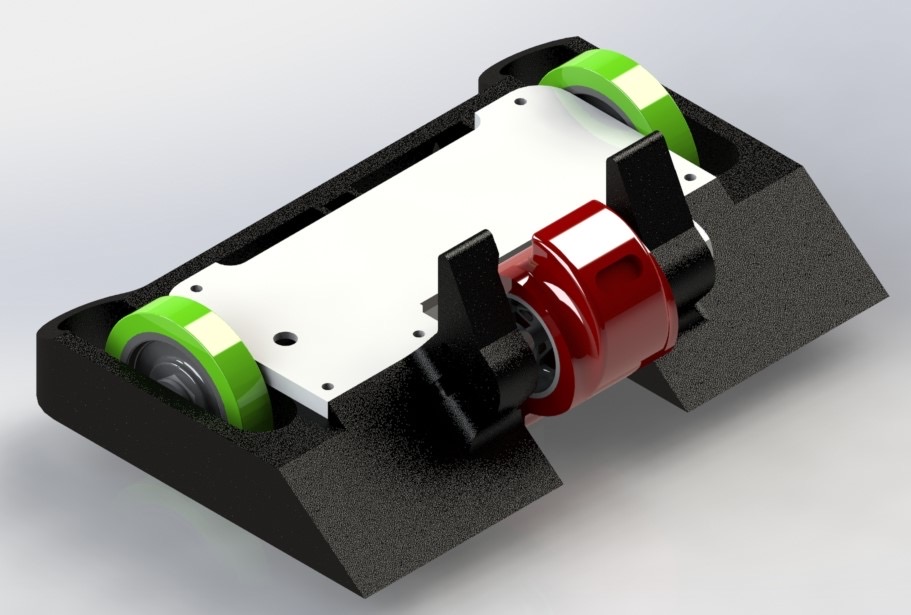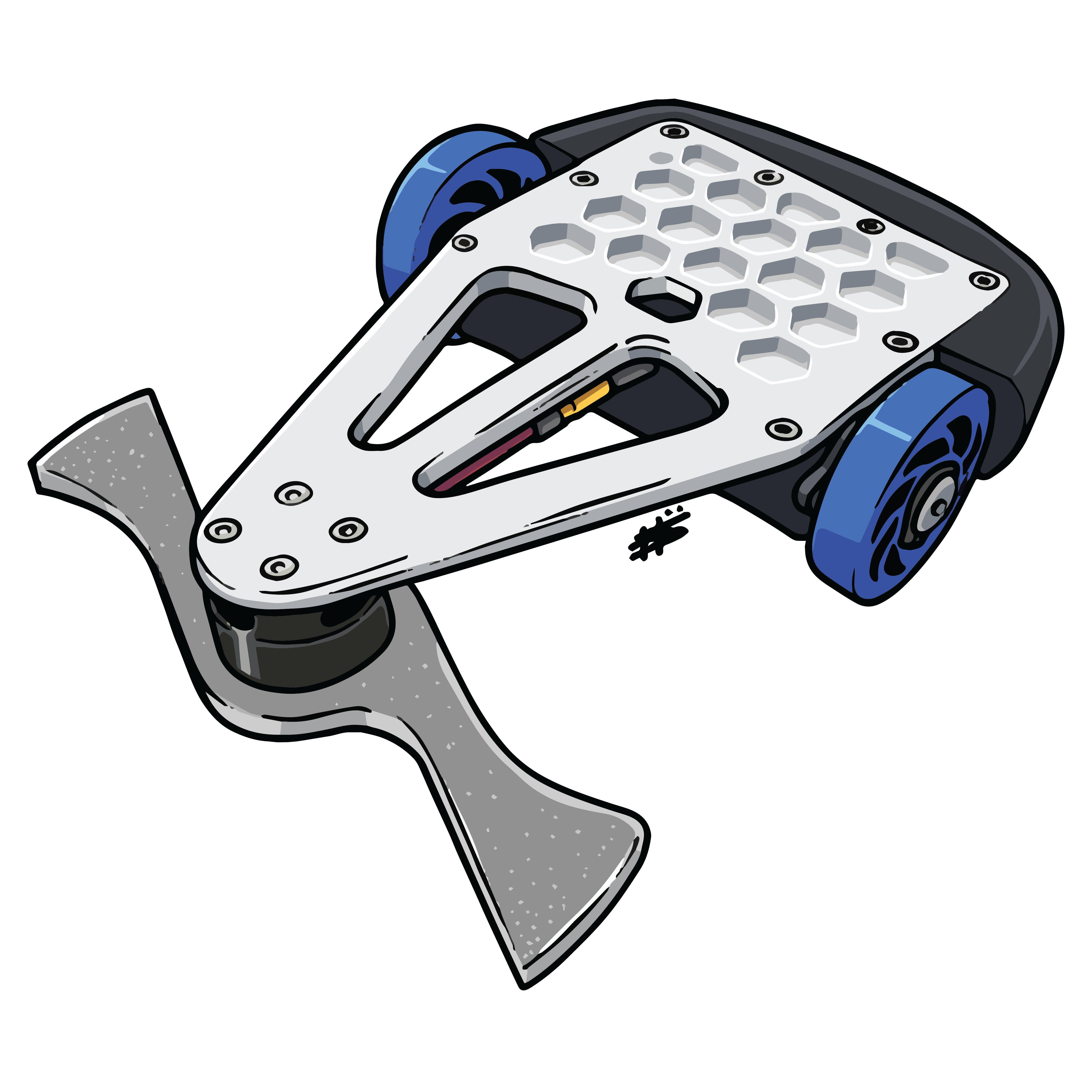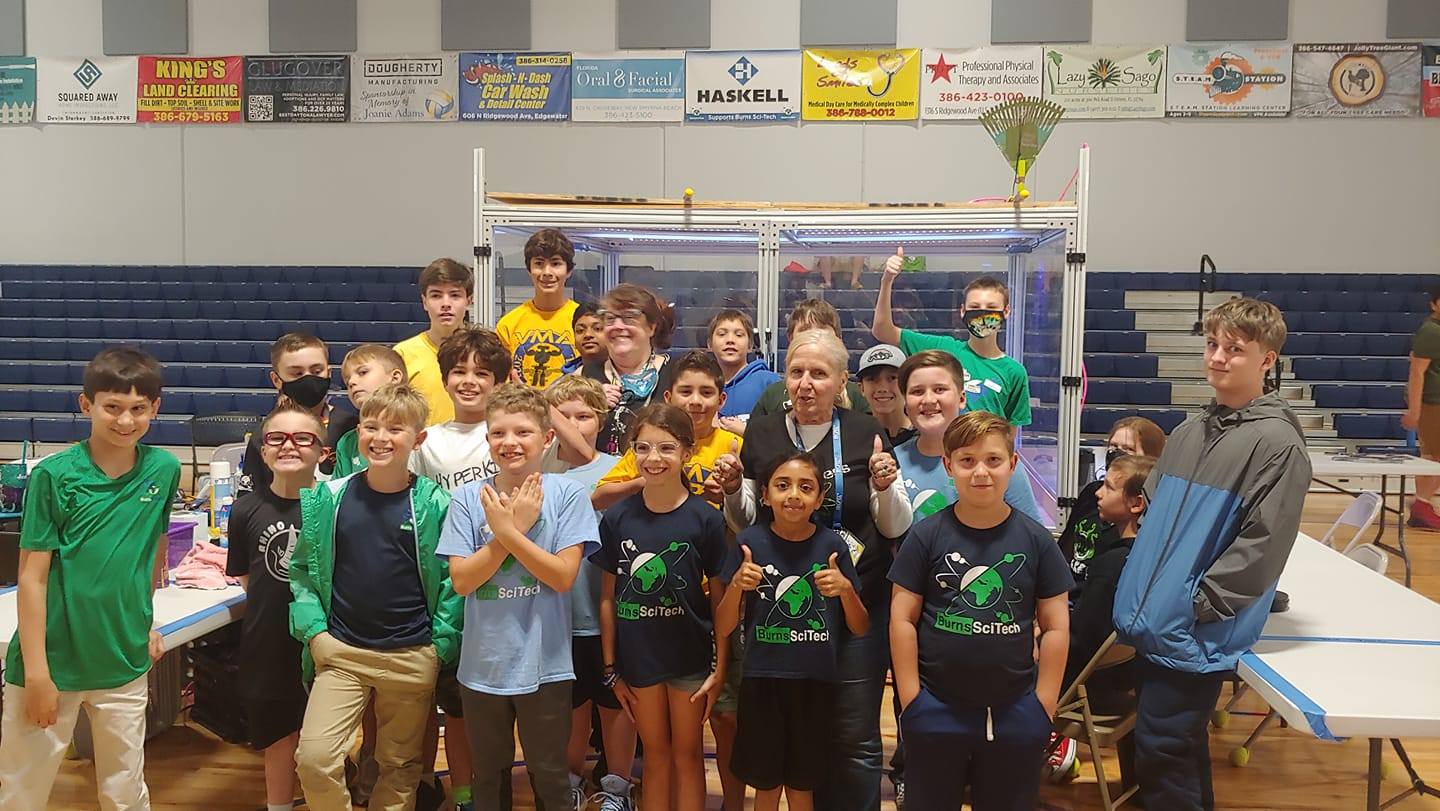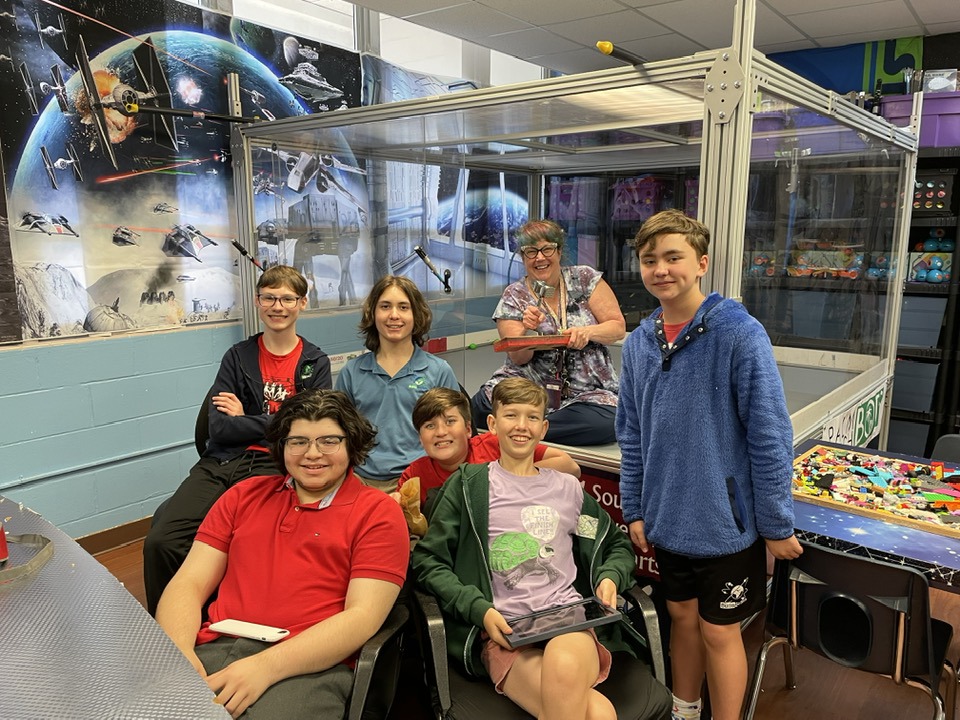
JediJill Presents- BST Bot Bouts 2023
Oak Hill, FL, US
June 10, 2023
Event Information
| Organizer: |
JediJill's Droid Lab Presents- BST Bot Bouts |
| Location: |
Burns Sci Tech Gym 160 Ridge Road Oak Hill, FL 32759 US Get Directions |
| Starts: | Jun 10, 2023 |
| Ends: | Jun 10, 2023 |
| Website: | https://www.jedijill.com/bst-bot-bouts.html |
Tournament Results
Event Organizers
Explore Who Competed
Event Description
JediJill’s Droid Lab presents:
“BST Bot Bouts!” Open to the Public to Enter on RCE: https://www.robotcombatevents.com/events/1072
Generously Sponsored By: Palm Beach Bots!!!
Team Kraken will be judging the matches and
Captain Matt Spurk will be the emcee and referee!
On Saturday, June 10, 2023, we will host the following competitions:
1lb. Ant-weights and 1lb. Plastic ant-weights in an 8' x 8' x 4' arena with a plywood floor.
1lb. bot hockey in teams in a 4’ x 4’ open arena with a shower board floor or another arena if it’s completed in time.
PRIZES!
Ants:
1st Place: $200.00
2nd Place: $150.00
3rd Place: $100.00
Plastic Ants:
1st Place: $100.00
2nd Place: $75.00
3rd Place: $50.00
Bot Hockey:
1st, 2nd, and 3rd Place: Team Prizes
Where: In our gym!
Burns Science and Technology School
160 Ridge Road
Oak Hill, FL 32759
When:
June 10, 2023
Event Times:
Saturday, 9:05 am - 6:45 pm for competitors and 10:30 am to 5:30 pm for patrons
Robot Safety Check-in will be in the afternoon-evening Friday, June 9th, from 1:30 pm to 6 pm. There will also be check-ins on Saturday from 9:15 am to 10:10 am.
Doors will not open for teams until AFTER 9:05 am on Saturday. Only volunteers, roboteers, and coaches are allowed in the gym before the doors open for patrons at 10:15 am. *Note: Doors will open at 8:40 am only for those who promise to help me set up for the tournament, and tear down the arena, and carry all the items back to JediJill’s lab after the event, 😉…and/or pledge a significant sponsorship to Team Kraken, or if you help and bring a couple dozen glazed Krispy Kreme donuts, 12 teabags of Twinings Irish Breakfast Tea, 1.68 oz of Liquid Splenda, 1 qt. of Heavy Cream, 1 gallon of filtered water, and an electric kettle to JediJill’s work table. 😉
Deadline for robot safety check-ins: 10:00 am on June 10th. Roboteers must bring robots that are ready for safety and ready to fight upon arrival.
The waitlist will update automatically once I post the event. Please keep an eye on “Robot Combat Events” for updates.
Release form with signatures and payment are NOT due until check-in-- we take cash, check, or credit.
1lb Ants- $20.00 entry fee (Open for 42 Entries)
1lb Plastic Ants- $10.00 entry fee (Open for 20 Entries)
1lb Bot Hockey- $1.00 entry fee per fight (Number of entries may be limited for time.)
All entry fees go to help fund JediJill’s Droid Lab
Robots may be disqualified at any time at the event organizer’s discretion.
Contact JediJill ahead of time if you are not sure your robot meets the SPARC ruleset.
http://sparc.tools/wordpress/wp-content/uploads/2019/SPARC_Robot_Construction_Specifications_v1.3.pdf
Event information: Check-in and safety inspections: Friday 1:30 pm to 5:30 pm Builders’ meeting: 5 pm Friday and 9:45 am Saturday. Brackets are Double Elimination, 2 minutes per match, and matches may begin as early as 10:15 am.
Tickets for all patrons, friends, and family are $2.00 per person for ages 5 and up. Ages 4 and under are free. We will have food and drinks for sale in concessions.
*Please note* Only the coaches and roboteers may enter the pit area!
Volunteers are needed to help run concessions, set up/tear down the arenas, carry equipment to and from JediJill’s Lab, and help us enforce rules such as care of the gym floor, NO littering, NO roughhousing, and NO running inside the gym during this event, help with restroom care, and help to keep the event running smoothly!
Some important rules:
1. Robots with active weapons must only be activated inside an arena! (This is rule #1! You will be disqualified immediately and receive NO refund of fees if you break this rule!)
2. Everyone MUST be as gentle as possible on the gym floor!!!!!!
3. No drilling or grinding inside buildings. We will have an area set up outside.
4. Only teams with great sportsmanship can compete and return for future tournaments!
5. Leave no trace anywhere! Clean up your pit area and leave NO trace of litter ANYWHERE on this campus! Always carry your trash with you until you find a bagged trashcan.
6. No flame weapons. Ask the event coordinators before you enter or at your safety check-in for all other questions about what is off-limits.
7. Only coaches and roboteers entered in the tournament are allowed in the pits!
8. A weapon lock is required for all weapons.
9. All Lipo batteries must be in a LiPo bag while charging. – Please bring your power strips and extension cords.
10. All coaches and builders are expected to follow basic safety practices during work on the robot/s at your pit station. Safety glasses must be worn in the pits.
11. No running, unsupervised children under age 18, or roughhousing is allowed indoors.
12. Please be alert and aware of your pit neighbors and be mindful of people passing by to get to and from the arena with their robots.
13. Please do not crowd the judges or staff working any arena. They need to concentrate and watch for safety issues.
14. NEVER block the path to the outer door from the arenas! We need to maintain a clear path to get hazards out of the gym immediately.
15. Be polite and patient with our staff!!!
Release and Waiver of Liability for Robot Combat Competition
I, [participant’s name] ___________________________________________________________, hereby acknowledge that I am voluntarily participating in the robot combat competition (“BST Bot Bouts”) held at Burns Science and Technology School on June 10, 2023. As a condition of my participation, I hereby agree to release and waive any and all claims against Burns Science and Technology School, its officers, employees, and agents, and any other parties affiliated with the Competition, including without limitation sponsors, volunteers, judges, and vendors (collectively, the “Released Parties”).
I understand that the Competition involves the use of robots and equipment that may cause injury or harm to myself or others, including but not limited to cuts, bruises, broken bones, or other serious injuries. I agree to assume all risks associated with my participation in the Competition, including the risk of death, and I acknowledge that the Competition involves physical activity that may be strenuous and dangerous.
I hereby waive, release, and discharge any and all claims for damages, injuries, or losses arising from my participation in the Competition, including any claims for negligence or breach of warranty without limitation. I understand that this waiver and release extends to all claims, whether known or unknown, arising from my participation in the Competition, including any claims that may arise in the future.
I agree to indemnify and hold the Released Parties harmless from any claims, actions, suits, demands, or liabilities of any kind or nature whatsoever, including reasonable attorney fees and expenses arising out of or related to my participation in the Competition.
I understand that this release and waiver is intended to be as broad and inclusive as permitted by the laws of the state in which the Competition is held and that if any portion of this release and waiver is held invalid, the remaining provisions will continue in full force and effect.
I have read this release and waiver of liability and fully understand its terms and significance.
I acknowledge signing this document voluntarily and of my own free will.
Participant’s Printed Name: ____________________________________________________________
Participant’s Signature: __________________________________________________________
Date: ________________________________________________________________
Bot Hockey League Official Ant-weight Rules
Version 1.0
Last edited: 5/1/23
Bot Hockey is an exciting and challenging game featuring two teams of three remote-controlled robots competing to score goals using a street hockey puck into a goal on either side of the Bot Hockey rink. The game rewards teamwork, driving skills, and strategy more than exotic materials and expensively built robots. The rules are a very simplified version of ice or street hockey rules with additions for the nature of the robotic players.
1.0 Robot Specifications
Bot Hockey robots are the means by which the game is played. They are small radio-controlled electric-powered vehicles used to move the game puck past the opposing robots to score by pushing or shooting the puck into the scoring zone. See section 2 for details on the puck and playing rink. Strict size and weight limits on the robots encourage teamwork, practice, and creativity in the design of robots. A wise team will select robots with complementary features to allow the team as a whole to maximize its effectiveness. Listed below are the specifications and restrictions on robots used in Bot Hockey matches.
1.1 Robot Configuration
Bot Hockey robots are normally wheeled devices with two or more powered wheels. However, other configurations such as legs, shuffle feet, ground effect hovering, and various snakelike configurations are allowed as long as the robots meet the size and weight limits listed below. Robots may not fly using airfoils, rotors, or ground effects above the height of the puck by any means. Hopping or jumping robots are allowed as long as they are not capable of jumping out of the playing rink.
1.2.0 Robot dimensions
Bot Hockey robots are limited to a strictly enforced universal weight in order to promote parity and fairness between teams.
1.2.1 Weight
Each team will have a maximum weight allowance of 3 lbs for their entire team of three bots. Each of the three robots will have a minimum weight of .5 lbs and a maximum weight of 1.5 lbs; the robots can share any remaining weight between the team to maximize effectiveness. The three bots must add up to 3 lbs at all times, regardless of substitutions that have occurred.
1.2.1 Robot size
When in normal playing configuration (see 1.2.2) must fit into a 9”x9”x9” cube. This size restriction will be measured by the Bot Hockey official before the competition begins. Each robot that will compete in the event must qualify with these restrictions before they are allowed to enter the competition.
1.2.2 Normal playing configuration
Normal playing configuration is defined as the robot’s configuration during the majority of the time in the match. Flipping or shooting devices may temporarily extend past the size limit but must immediately retract. The definition of immediately is up to the Bot Hockey officials. At the official's discretion, they can pause the match and award a penalty if they believe this rule has been violated. Unfolding scoops, wings, arms, or other devices designed to extend and increase the size of the robot beyond the specified sizes are not allowed.
1.3 Power
Electric batteries and electric motors must solely power the drive and control system of the robots. Shooters and other puck-handling equipment can be powered by alternative power sources and controlled by electronics, such as pneumatics. No internal combustion, fuel cell, or other means of providing power are allowed.
1.3.1 Batteries
Batteries must be of a construction that is spill-proof in all orientations. Suggested battery types are Nickel Cadmium, Nickel Metal hydride, and Lithium Polymer. Immobilized electrolyte (gel-cell or absorbed glass mat) lead-acid batteries may be used as well. Batteries using exotic chemistry or construction that can result in the release of toxic gas or liquid during normal operation are not allowed. If in doubt about the battery type you wish to use, contact the event organizer. Batteries are still dangerous, and the event organizer will be prepared with the proper safety precautions in the event of a battery life.
1.3.2 Battery voltage
Battery voltage is limited to 48 volts. This is defined as the rated voltage of the battery array.
1.4 Radio Control
Robots are normally controlled by radio systems operating in approved frequency bands for ground vehicles in the country where the tournament is held.
1.4.1 Radio bands
Common frequency bands for ground vehicles are 75MHz (hobby R/C) and the 900MHz and 2.4GHz ISM bands. 72MHz band R/C radios are restricted to air vehicles and may not be used for Bot Hockey matches. Other frequency bands, such as 50MHz, 433 MHz, and 27MHz / 49MHz bands, may also be used. Tournament organizers may disallow the use of radios operating in some of these bands. Countries outside the US will have different frequency bands allowed for use. Teams are responsible for ensuring their robots meet the radio requirements of the tournament. Tournament organizers will explicitly announce any restrictions or changes to the common frequency bands (75MHz, 900MHz, 2.4GHz, 49MHz, and 27MHz).
1.4.2 Frequency modulation
Any type of frequency modulation may be used to control Bot Hockey robots. Specifically, low-cost AM and toy-style radios are allowed.
1.4.3 Other radios
Digital data modem radios, wireless networking, or other types of data radios are allowed to be consistent with frequency band requirements in the country where the tournament is held. Tournament organizers may restrict some types of data communications, such as wireless network adapters that might interfere with tournament data systems.
1.5 Other Control Systems
Other types of control systems, such as infrared, ultrasonic, or laser, may be used, subject to approval by the tournament organizer. In general, non-radio control systems must be eye-safe for players and spectators and not disrupt the conduct of the tournament, e.g., audible sound-based systems. Teams wishing to use non-radio control systems must receive approval from the tournament organizer before using the system. Autonomous control systems are allowed as long as they can be toggled on or off wirelessly.
1.6 Weapons
Bot Hockey robots should not have weapons or devices intended for damaging the competitor robots, the playing rink, or the puck. At the tournament organizer’s discretion, any robot may be disqualified if it is deemed to violate the spirit of this rule, even if the robot otherwise meets the letter of the rules below.
1.6.1 Allowed devices
Weapons for only controlling opposing robots include pneumatic or electric lifting and flipping arms, and clamping devices are not allowed. Any of the previously mentioned weapon types that also are designed to control, shoot or direct the puck are allowed and encouraged. If they have a dual purpose, that is allowed.
1.6.2 Sharp weapons or edges
Points, spikes, and cutting edges are not allowed on robots. Any feature of a robot likely to cause injury to a person’s unprotected hand while giving it a hard slap will most likely be disqualified. Metal wedges are allowed but should not be sharpened significantly. The event officials will have the final say on what defines sharp or likely to cause injury.
1.6.3 Kinetic energy weapons
Continuously spinning weapons or devices such as spinning saw blades, bars, drums, disks, or other devices designed to impact other robots or the puck are not allowed.
1.6.4 Other illegal weapons
Piercing or stabbing weapons such as pneumatic or spring-powered spears or hammers with points are not allowed. Hammer-like devices that impact downward and are obviously not intended to move the puck are not allowed, even if they don’t include a piercing point.
1.6.5 Entanglement
Entangling weapons such as string, cables, tape, nets, glue, and other devices intended to entangle the opposing robots are not allowed. Puck shooting devices may be deemed entangling weapons by the event officials if they present a significant risk of entanglement when not being used to move the puck.
1.6.6 Liquids
No liquids of any kind may be released from the robot during use. This includes water or other liquid from cooling systems or otherwise used for robot operation. Teams may incur a forfeit loss for fouling the playing rink intentionally or unintentionally.
1.6.7 Combustion
Flame weapons or effects are not allowed.
1.6.8 Jamming, Zapping, and Interference
Electric or electronic jamming or zapping using devices such as radio jammers, high-voltage coils, stun guns, cattle prods, etc., are not allowed. Intentional interference with radio or other control systems is also not allowed.
1.6.9 Visual interference
Visual interference, such as bright lights, strobes, lasers, smoke, chaff, or other means of interfering with the opposing driver's view, is not allowed.
1.6.10 Deployable devices
Robots may not intentionally drop or detach parts or objects onto the rink. Devices such as caltrops, spik strips, speed bumps, or any other object deployed intentionally from a robot are forbidden.
1.7 Shooters
The addition of active devices on robots to shoot, kick, or flip the puck is encouraged. These devices make for a faster and more exciting game and allow teams to avoid traffic jams and pushing matches. Passing and long-range shooting increase a team’s ability to score and benefit from set plays and maneuvers to defeat an opposing team. Shooters shall shoot the puck at speeds no faster than 25 MPH.
1.7.1 Flipping shooters
Flipping or kicking-type shooters should act in a mostly horizontal manner. Some vertical motion is allowed, but penalties may result if the puck is flipped out of the playing area. See Section 3, Rules of the Game.
1.7.2 Spinning shooters
A continuously spinning shooter may be included on a robot as long as the following conditions are met.
1.7.2.1 Enclosed spinner
The spinning shooter must be completely enclosed in the robot’s body so no other robot or part of the rink can contact it.
1.7.2.2 Horizontal shooter
The shooter must project the puck in a horizontal fashion parallel to the surface of the rink. A wild shooting penalty can be assessed if the puck is shot with velocity.
1.7.3 Lifting and clamping
Lifting and clamping devices are allowed to control the other robots and the puck. Such devices must be designed to release on command.
1.8 Engulfing
The general play of the game requires robots designed to push or kick the puck toward the goal. In order to be able to know when a goal was scored, the puck must be visible at all times, and bots designed to inhibit the visibility of the puck are illegal. Robots may not be designed to cover or engulf the puck and hide it from view. Controlling the puck by grabbing it with a clamp or claw is allowed as long as the puck is clearly visible and not enclosed in the robot's body in any way.
1.9 Power switch
Some form of the power switch is required to turn all power on or off on your bot hockey bot quickly and easily. This can be a screw or slide switch, a removable link, or anything else that is easily accessible with minimal effort. Bots should be switched on and off inside the rink or immobilized on the edge of the rink for the safety of all. During the initial weigh-in and measuring of all bots, checking for a power switch will also occur. A power LED is not required but is recommended.
2.0 The Playing Rink
2.1. Rink Size.
The rink is 8 feet long by 4 feet wide, with 1-foot radius curves along the sides.
2.2. Goals.
The goals are 12” wide and 6” high and are centered on both sides of the rink. The goal should be at least 10” deep and should not be contained or covered in any way. You should be able to reach the goal and pick up a robot or puck. The goal should contain walls on all sides to prevent pucks and robots from leaving the playing rink.
2.3. Walls.
The walls are a minimum of 6" high and a maximum of 12” high.
2.4. Scoreboard
A large countdown timer should be easily visible to all team members. This scoreboard should show each team's score and time remaining
2.5 Floor material
The floor can be made of any material that allows the puck to slide easily while providing adequate traction to the competitors. The floor should be as close to level as possible.
3.0 The Rules of the Game
Bot Hockey is a game modeled on hockey. The goal of the game is to score more points than the other team by pushing or shooting a 1.5”x0.5” puck into your opponent's goal area more than your opponents. In order to encourage a fast and exciting game and to accommodate the nature of the players, the rules of ice hockey are highly modified and simplified.
3.1. Game Length.
Games last 5 minutes from the initial puck drop. The referee can blow their whistle to stop play at any time. They can blow their whistle again to resume play. The referee will blow their whistle three times in succession to signify the end of the game.
3.2. Game Flow.
Bot Hockey is designed to be fast-moving and to feature continuous action with very few breaks in play between periods.
3.2.1. Start of play
Play starts with all 3 robots from each team on their own half of the rink. The official tosses the puck approximately on the centerline, blows their whistle, and play begins.
3.2.2. Icing or offsides
Robots may move anywhere within the playing rink at any time. There are no offsides or icing in Bot Hockey.
3.2.3 Checking
Checking and blocking opposing robots is allowed at any time and for any length of time.
3.2.4. Scoring
Robots move the puck into the goal area on the opposing team’s half of the rink to score. Scoring may take place by pushing or shooting the puck into the goal. When the official decides the puck has crossed the line, they shall signal a goal by blowing their whistles.
3.2.5. Goal line
The puck must be completely over the goal line and inside the goal area to score a goal. Goals may be scored with the puck on the playing surface, in the air, on top of, or even under a robot.
3.2.6. Pucks shot out of play
A puck that is shot or flipped directly outside the playing area will award a penalty to the team that caused the puck to leave play. Pucks that travel outside due to collision or by deflecting off an opposing robot or the rink will not cause a penalty to be called.
3.2.7. After a goal
Whenever a goal is scored or the puck leaves the playing surface, the puck is immediately tossed back into play at the centerline of the rink by the referee. Referees should have at least 2 pucks in order to place one in play immediately while the other is retrieved from the goal or fetched back to the playing area. There is no time allowed after a goal for regrouping or repositioning the robots after a goal was scored. Referees will have to retrieve the pucks from inside the goal, which is dangerous for the official when the referee blows the whistle to signal the goal (3.2.4). If your bot is near the goal, IMMEDIATELY stop moving your robot until the referee has moved their hand away from the goal area. If the robot moves while a referee's hand is close to their bot after the whistle is blown, they will receive a warning from the official. If the robot continues the behavior, a penalty can be awarded to the team.
3.2.8. End of match procedure
Play continues until time has expired. When time has expired the robots are immediately removed from the rink to allow the next match to proceed.
3.2.9. Winning
The winner of the match is the team with the highest score at the end of play. If there is a tie, overtime shall commence.
3.3. Substitutions
Robots may be replaced at any time during the match.
3.3.1. Substitution procedure
The procedure for substitution is as follows: first, the robot to be replaced is removed from the playing rink, and then the substituting robot is placed onto the playing rink. Play does not stop for substitutions. At no time may a team have more than three robots on the rink. If there is an illegal substitution, the referee may award a penalty to the team.
3.3.2. Robot that can’t be reached
If a robot is disabled in the center of the rink and cannot be reached from the edge of the rink, the referee can decide to stop the clock to allow the team to remove the disabled robot. Either team may also assist with moving a disabled robot to the edges so it can be retrieved.
3.3.3. Robot out of the arena
If a robot is knocked or flipped out of the playing rink, it can be immediately replaced with a substitute.
3.3.4 Number of Substitutes
You may have up to 3 substitutes ready to go at any time as long as they all follow all rules and are approved by the officials.
3.3.5 Reaching into the Arena
Only the 3 drivers and a single other designated person per team may initiate substitutions. You may not physically block or impede a person trying to substitute a bot. Reaching into the arena to substitute a robot can be dangerous, and if a dangerous substitution occurs, the ref may assess a penalty to the team.
3.4. Sudden Death.
There are no tie matches in Bot Hockey. If time expires with a tie score, the game immediately moves into sudden death overtime. During sudden death overtime, play proceeds as before, with the first team to score a goal winning the match.
3.5. Dead Robots.
It is possible that in some matches, some or all of the robots on the rink may be disabled, and no substitutes are available. In this case, the following rules apply:
3.5.1. Dead robots
If all the robots on both teams are disabled or unable to move, the game is paused, and the referee will discuss with both teams to see if it’s likely at least one robot will be available to be repaired within the remainder of the game time. If the referee decides the answer is yes, the game clock will resume while both teams try to repair their bots. If the referee decides both teams won’t be able to have a single working robot between them with the remaining time, the game is declared over. If this match is a tie and there are no bots available to play in the match, the match will be postponed for an amount of time decided on by the official to repair the robots.
3.5.2 Dead robots on one team only
If one team has no remaining functional robots, they are encouraged to forfeit. If they do not, the referee may end the game early and award the victory to the team with functional robots.
3.6. Penalties
There are very few penalties in Bot Hockey. Those that exist are intended to keep play moving and to avoid gratuitous destruction of opposing robots and ensure the safety of all participants and officials.
3.6.1. Unsportsmanlike Conduct
If the referee determines that a team is intentionally damaging an opposing robot not in the course of play in an unsportsmanlike fashion, for example, continuously damaging a disabled robot, the official may declare an unsportsmanlike conduct penalty. This results in a penalty for the team to be awarded.
3.6.2. Wild shooting
If a robot shoots, flips, or otherwise projects the puck out of the playing rink, a penalty will be awarded to the offending robot. Pucks ejected in the course of a collision or by deflecting off other robots or the rink will not be considered wild shooting.
3.6.3. Illegal Substitution
If, at any time, a team has four or more robots on the rink, an invalid substitution penalty will be called, and the team will be awarded a penalty.
3.6.4 Weight and size challenge
During the game, if the opposing team thinks the other team is not in compliance with the weight or size limit, they may verbally ask the official for a challenge. The referee will blow their whistle, and the game will pause. The robots will be reweighed and measured quickly to determine if the team is in compliance. If they are not compliant, that robot will be disqualified for the remainder of the event, and the team will receive a penalty. If the team that called for the challenge was incorrect about their challenge, they will incur a penalty and can no longer call a challenge the rest of the match.
3.6.5 Penalties and Power Plays
A penalty can be awarded for multiple reasons:
-Weight and size challenge
-Illegal or dangerous substitution penalty
-Wild shooting penalty
-Unsportsmanlike conduct penalty
-Moving your bot while an official is reaching in to retrieve the puck
-Flipping or shooting mechanisms violating the size requirement
If a penalty is awarded, the referee will blow the whistle to stop the play. The penalty will then be awarded, and the robot that committed the must be removed from play for 60 seconds, creating a power play for the opposing team. Once the 60-second penalty is over, the robot may reenter the game. The opposing team may score as many times as they want on the power play. If the referee believes the player did not serve their penalty properly, they will be given another penalty
3.7. Forfeit
If, at the beginning of the game, a team does not place at least one robot into play, a forfeit will be declared, and the match will be awarded to the opposing team, assuming they have at least one robot ready to play. If both teams cannot place a robot into play, the match shall be played at a later time, or the event organizer may decide other resolutions as long as a winner and loser are decided - there are no ties in Bot Hockey.

